
Mare Imbrium is a vast lava plain within the Imbrium Basin on the Moon and is one of the larger craters in the Solar System. The Imbrium Basin formed from the collision of a proto-planet during the Late Heavy Bombardment. Basaltic lava later flooded the giant crater to form the flat volcanic plain seen today. The basin's age has been estimated using uranium–lead dating methods to 3938 ± 4 million years ago, the diameter of the impactor has been estimated to be 250 ± 25 km. The Moon's maria have fewer features than other areas of the Moon because molten lava pooled in the craters and formed a relatively smooth surface. Mare Imbrium is not as flat as it was originally thought, because later events have altered its surface.

Mare Serenitatis is a lunar mare located to the east of Mare Imbrium on the Moon. Its diameter is 674 km (419 mi).
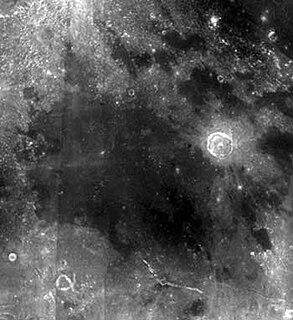
Mare Vaporum is a lunar mare located between the southwest rim of Mare Serenitatis and the southeast rim of Mare Imbrium. It was named by Giovanni Battista Riccioli in 1651.

Montes Haemus is a mountain range that forms the southwestern edge of the Mare Serenitatis basin on the Moon. They form a less prominent mirror image of the Montes Apenninus range to the west, and curve up to nearly join at the northern end. The eastern edge terminates with the Promontorium Archerusia, to the northwest of the crater Plinius. This end reaches a gap where the Mare Serenitatis to the north joins the Mare Tranquillitatis to the south.
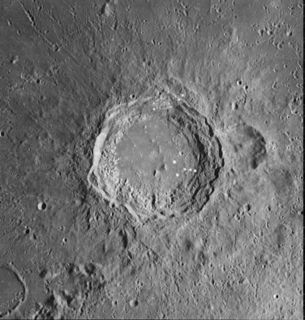
Aristoteles is a lunar impact crater that lies near the southern edge of the Mare Frigoris and to the east of the Montes Alpes mountain range. It was officially named in 1935 after the ancient Greek philosopher Aristotle by the International Astronomical Union, using the classical form of his name.
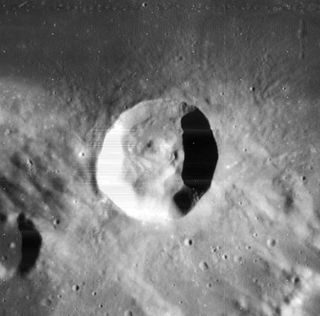
Menelaus is a young lunar impact crater located on the southern shore of Mare Serenitatis near the eastern end of the Montes Hæmus mountain range. Its diameter is 27 km. To the southwest is the small crater Auwers, and to the west-southwest is the even smaller Daubrée. To the northeast is a faint rille system named the Rimae Menelaus.

Aratus is a small lunar impact crater located on the highland to the south and east of the rugged Montes Apenninus range. It is a circular, cup-shaped crater with a relatively high albedo. It was named after Greek astronomer Aratus of Soli. To the east is the Mare Serenitatis, and to the southwest is the somewhat larger crater Conon. North-northeast of Aratus is the landing site of the Apollo 15 mission, just beyond Mons Hadley Delta.

Eudoxus is a prominent lunar impact crater that lies to the east of the northern tip of the Montes Caucasus range. It is named after the Greek astronomer Eudoxus of Cnidus. It is located to the south of the prominent crater Aristoteles in the northern regions of the visible Moon. To the south is the ruined formation of Alexander, and the small crater Lamèch lies to the southwest.

Alexander is a lunar impact crater-like feature in the rugged surface to the north of Mare Serenitatis. It lies to the south-southwest of the prominent crater Eudoxus, and to the east-northeast of Calippus. It was named after Alexander the Great.

Calippus is a small lunar impact crater that is located on the eastern edge of the rugged Montes Caucasus mountain range in the northern part of the Moon. It was named after Greek astronomer Callippus of Cyzicus. It lies to the southwest of the crater remnant Alexander, to the northwest of the Mare Serenitatis.

Montes Alpes is a mountain range in the northern part of the Moon's near side. It was named after the Alps in Europe; the name was confirmed by the International Astronomical Union in 1935. It lies between the selenographic coordinates latitudes 52.81°N and 42.04°N, and longitudes 5.6°W and 3.22°E. The range thus crosses the lunar prime meridian, and is partially illuminated and partially in shadow during first and last quarters. The center of the range is at 48.36°N, 0.58°W, and has a diameter of 334 km.

Mons Pico is a solitary lunar mountain that lies in the northern part of the Mare Imbrium basin, to the south of the dark-floored crater Plato and on the southern rim of a ghost crater. This peak forms part of the surviving inner ring of the Imbrium basin, continuing to the northwest and with the Montes Teneriffe and Montes Recti ranges, and probably to the southeast with the Montes Spitzbergen. This mountain feature was most likely named by Schröter for the Pico von Teneriffe (Teide).

Lacus Somniorum is a basaltic plain located in the northeastern part of the Moon's near side. It is located at selenographic coordinates 37.56° N, 30.8° E, and has a diameter of 424.76 kilometers. The name is Latin for Lake of Dreams, a title given to this feature by Giovanni Riccioli. It is the largest of the lunar features designated Lacus.

Montes Cordillera is a mountain range on the Moon. This feature forms the outer wall of peaks that surround the Mare Orientale impact basin, the inner ring being formed by the Montes Rook. The center of the range is located at selenographic coordinates 17.5° S, 81.6° W, and the diameter is 574 km (357 mi).

Mons Piton is an isolated lunar mountain that is located in the eastern part of the Mare Imbrium, to the north-northwest of the crater Aristillus. Due east of Mons Piton is the flooded crater Cassini, and to the west-northwest lies Piazzi Smyth. North and northeast of this massif is the Montes Alpes range, forming the northeast edge of the lunar mare.

Montes Rook is a ring-shaped mountain range that lies along the western limb of the Moon, crossing over to the far side. It completely encircles the Mare Orientale, and forms part of a massive impact basin feature. This range in turn is encircled by the larger Montes Cordillera, which is separated from the Montes Rook by a rugged, ring-shaped plain.
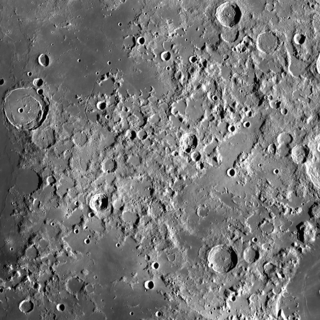
Montes Taurus is a rugged, jumbled mountainous region on the Moon. It is located to the east of the Mare Serenitatis, in the northeastern quadrant of the Moon's near side. Coordinates of their center are 27.32°N 40.34°E, and their extent is about 170 km.

Taurus–Littrow is a lunar valley located on the near side at the coordinates 20.0°N 31.0°E. It served as the landing site for the American Apollo 17 mission in December 1972, the last crewed mission to the Moon. The valley is located on the southeastern edge of Mare Serenitatis along a ring of mountains formed between 3.8 and 3.9 billion years ago when a large object impacted the Moon, forming the Serenitatis basin and pushing rock outward and upward. Taurus–Littrow is located in the Taurus mountain range and south of Littrow crater, features from which the valley received its name. The valley's name, coined by the Apollo 17 crew, was approved by the International Astronomical Union in 1973.

Montes Apenninus are a rugged mountain range on the northern part of the Moon's near side. They are named after the Apennine Mountains in Italy. With their formation dating back about 3.9 billion years, Montes Apenninus are still relatively young.
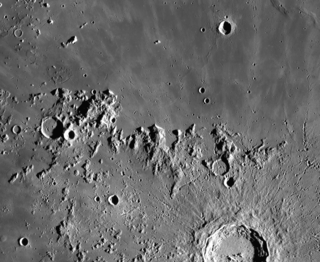
Montes Carpatus is a mountain range that forms the southern edge of the Mare Imbrium on the Moon. The selenographic coordinates of this range are 14.5° N, 24.4° W, and the formation has an overall diameter of 361 km (224 mi). They were named by astronomer Johann Heinrich von Mädler after the Carpathian Mountains in Central Europe.




















